Bringing Patients for Physiotherapy Clinics
Physical Therapy Marketing
Physical therapy marketing has long bridged traditional and digital media to reach patients.
While traditional press still has some influence, in the last decade, medical marketing efforts have cropped up largely through digital methods like Search Engine Optimization (SEO), content creation, email, and paid ads.
In 2025, we’re seeing the landscape advance variably. SEO and content strategies are now more complex and optimized for super-specific audiences. Social media, data-driven insights, and artificial intelligence, once innovative but niche, are now must-haves in any strategy. Are you staying current with these changes? Dive into what’s new and what ‘breakthrough physical therapy marketing’ entails as of today.
Physical Therapy Market Analysis: Canada and Global Scenes in 2025
The post-pandemic period offers immense opportunities for Canadian physical therapists and the healthcare industry.
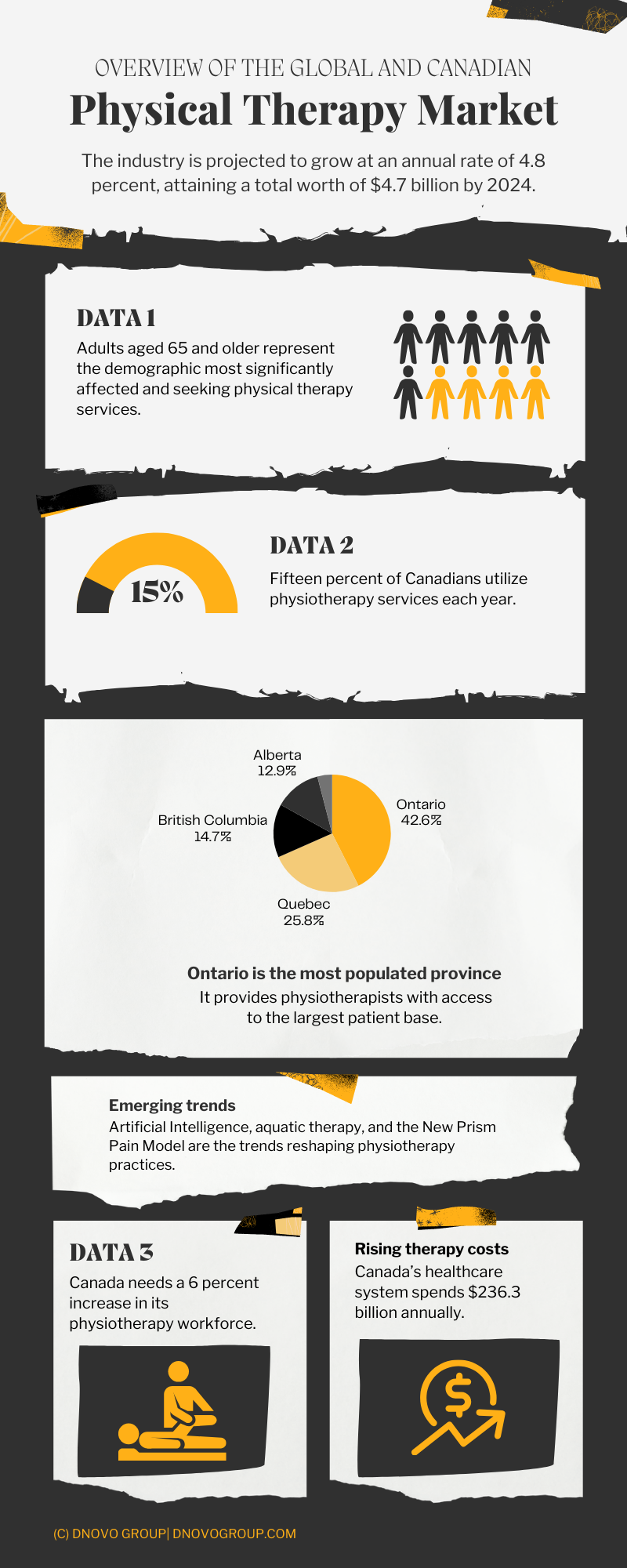
Here’s a look at the trends, market dynamics, and challenges ahead:
Global Physical Therapy Market Size
A recent 2024-2029 GlobeNewswire report projects the market will expand at a CAGR of 4.8 percent, reaching a value of $4.7 billion by 2024. In Canada alone, 15 percent of people use physiotherapy services annually. The upward trend points to increasing demand for physiotherapists domestically and worldwide.
Current trends in physical therapy
The pandemic fast-tracked innovation in the field, giving us tools like telemedicine, mobile apps, and better protective measures. As a result, practitioners were able to maintain their income streams. Drawing from insights in this article, lately, there’s also been heightened interest in:
- AI-driven therapies for personalized treatment.
- Aquatic therapy as an emerging corner.
- The New Prism Pain Model, which is reshaping pain management practices.
Aging population: The driving force
People aged 65+ are the biggest group seeking physical therapy. With chronic conditions like musculoskeletal disorders rising, there’s a higher demand for advanced solutions.
Healthcare providers, in response, are stretching their treatment options to tackle the needs of this expanding patient segment. Data reveals physical therapy cuts the economic hit from conditions like osteoarthritis, back pain, and coronary heart disease by $232 million (5 percent) every year.
Ontario: The biggest market for physical therapy
Ontario, as Canada’s most populated province, gives physiotherapists access to the largest pool of patients. Its mix of urban hubs and a growing elderly population makes it a prime spot for administering physical therapy services.
Why patients stay loyal
Patients value consistency in their care. Many prefer to stick with the same trusted therapist to avoid interruptions. There’s also evidence that strong relationships between therapists and patients play a role in keeping patients loyal, regardless of fluctuating prices.
Challenges for physiotherapy practices
Even though things look promising, two hurdles remain:
Rising costs. Therapy costs keep climbing, with operational expenses eating into profits. In fact, Canada’s healthcare system spends about $236.3 billion yearly, according to the Public Health Agency of Canada.
Staffing shortages. There aren’t enough physical therapists to meet demand, especially in geriatrics. New grads can’t fill the gap fast enough. Canada already trails other countries in the number of physiotherapists per capita. To match the OECD average, Canada would need a 6 percent increase in its physiotherapy workforce.
Physical Therapy Marketing Ideas: What Physical Therapists Should Replan
If you’ve already developed a physical therapy marketing plan that leans on SEO and content production, it’s worth taking a step back to evaluate them against fresher, emerging approaches.
Of course, different sources have their own ways of categorizing marketing strategies for physical therapy.
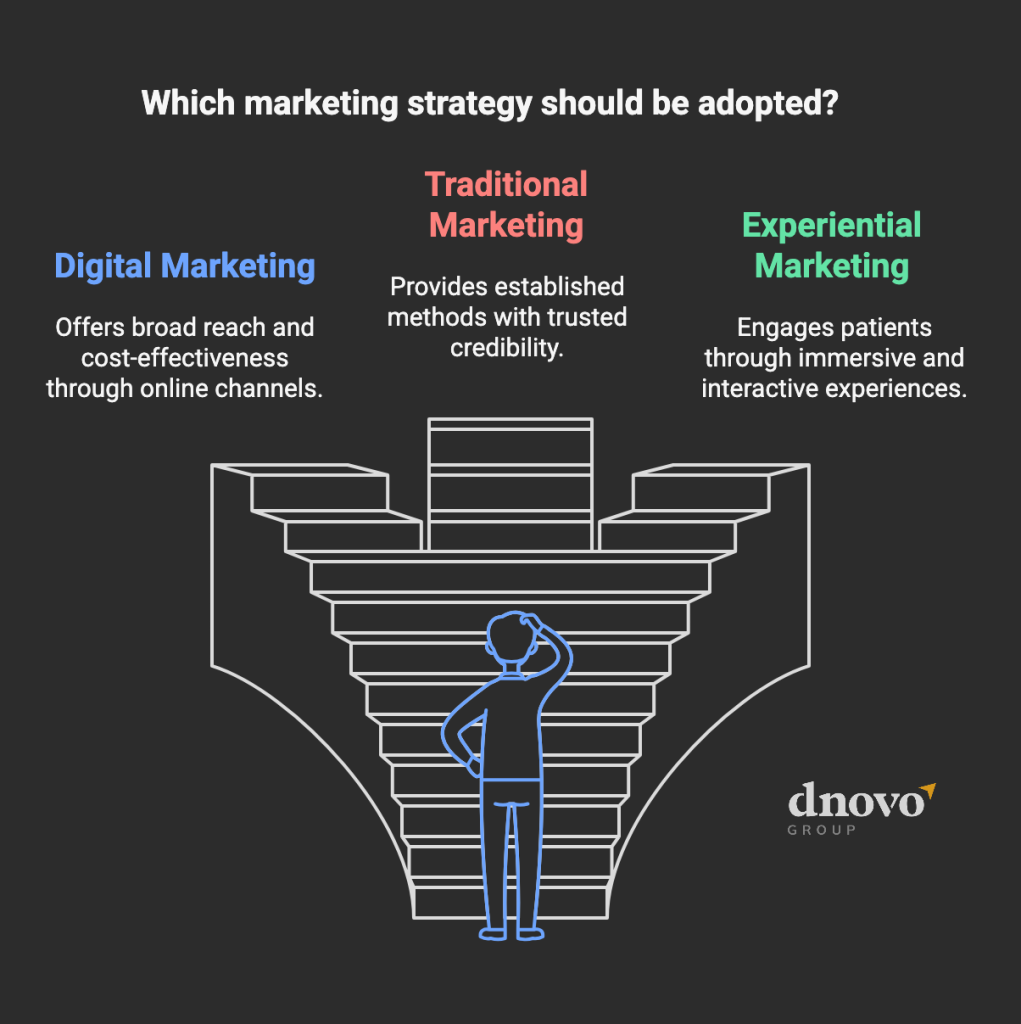
Image explaining different marketing strategies for physical therapy.
It really comes down to three fundamental classes:
Digital marketing
This is when you use online platforms and technology to engage with existing and prospective patients. Digital marketing comprises:
- SEO
- Content marketing
- Social media marketing
- Pay-per-click advertising (PPC)
- Email marketing
- Affiliate marketing
- Influencer marketing
- Performance marketing (cost-per-click, cost-per-action, and cost-per-view.)
What should you replan?
Your content. Two years ago, the list above was practically all you needed to run a successful digital marketing campaign. But following innumerable updates to how Google’s search engine ranks content now, mostly due to ultra-high generative AI usage, things are changing fast.
The benefits are undoubtedly because according to Google, they will prioritize helpful, reliable, and people-first content. If you peek closer, many brands are now pushing for more creative, authentic, and even absurd content.
We especially liked how this article from Edu Studio explains the idea; they dub it “the weirding of content.” Physiotherapy examples are rare for this, but we found an ad from eight years ago that’s close to what Edu Studio talks about.

Creative video advertorial for Nuffield Health’s physical therapy services.
At the same time, the downsides of these changes are taking marketers themselves by surprise, with massive declines in traffic being one of the main concerns. For example, Ryan Law, Director of Content Marketing at Ahrefs, shared a snapshot on LinkedIn (January 23, 2025), suggesting a significant drop in Hubspot’s web traffic.
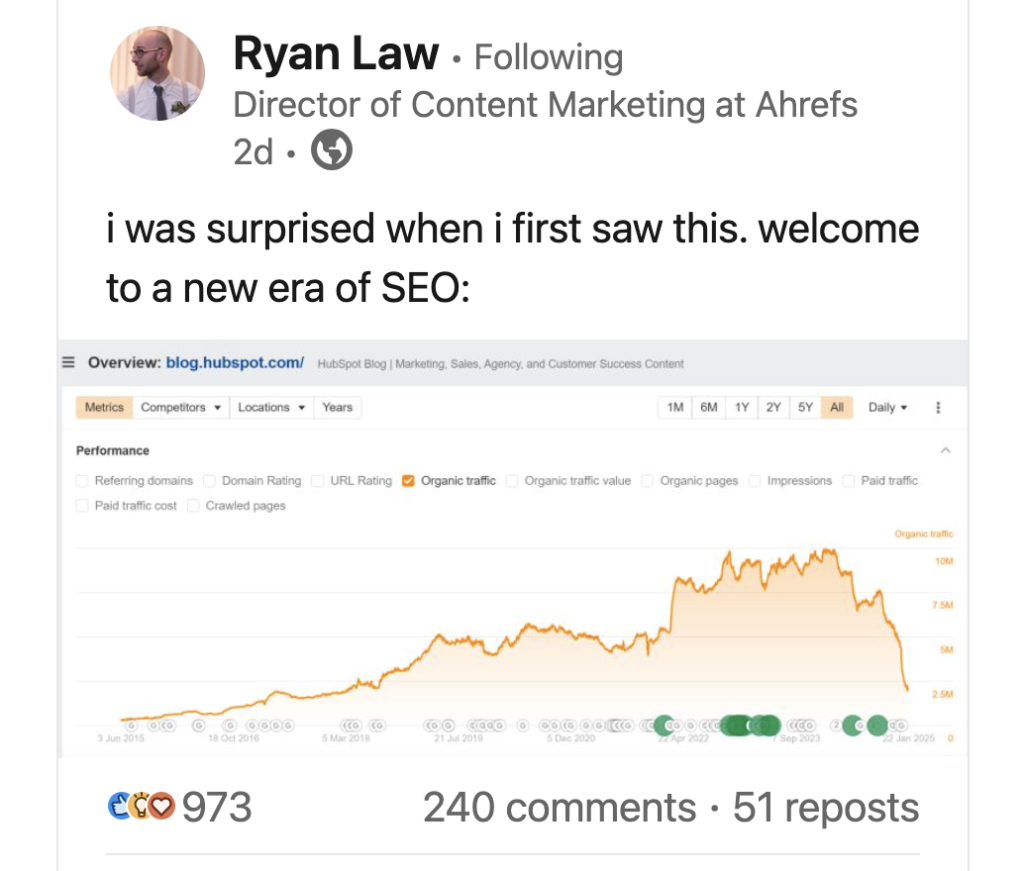
Screengrab showing drops in web traffic due to new Google updates.
This is an interesting case because Hubspot’s a big name in marketing, so if even they’re getting hit, imagine what could happen to smaller brands if Google decided to crack down harder. This only speaks to one thing: It is time to adapt, more so for very niche spots like physical therapy.
Your strategy. Marketers have been infamous for jumping on trends, but since 2023, no topic has captured the collective imagination quite like generative AI. In 2024, a new term entered the lexicon: Agentic AI. While 90 percent of marketers use generative AI at least monthly, mostly to spin up creative ideas and streamline content production, agentic AI is still an enigma—not many use cases are around.
IBM did a good job explaining the technical bits; however, what is clear as day is that AI agents are going to be revolutionary to SEO. Conversations have it that AI will soon act as full-scale SEO agents, overseeing functions, from keyword analysis to content optimization and placement.
Our stance as a digital marketing agency is that AI is thought to be an essential marketing tool today, but its effectiveness must be grounded in data a.k.a data-driven marketing. If brands continue to produce low-quality, spammy, and irrelevant content, the outcome will be no different—volumes of web traffic wiped out in an instant, as Google has explicitly warned.
Your searchability. This refers to how easily your content, brand, or website can be found through online search engines like Google. Projections point to search diversification, implying that Google’s long-standing monopoly may be on shaky ground. With the launch of OpenAI’s SearchGPT, users can now quickly get answers through ChatGPT. This may further ramp up competition between Google Search and AI-driven search/answer engines like ChatGPT and its newest challenger, DeepSeek. Answer engines are likely to erode website click-through rates as users veer off Google searches.
Social media has slowly become a key player in search. YouTube, Reddit, and Quora have been recognized as alternative hubs for finding information, including user-generated content and niche expertise. But the wildcard in this space is TikTok.
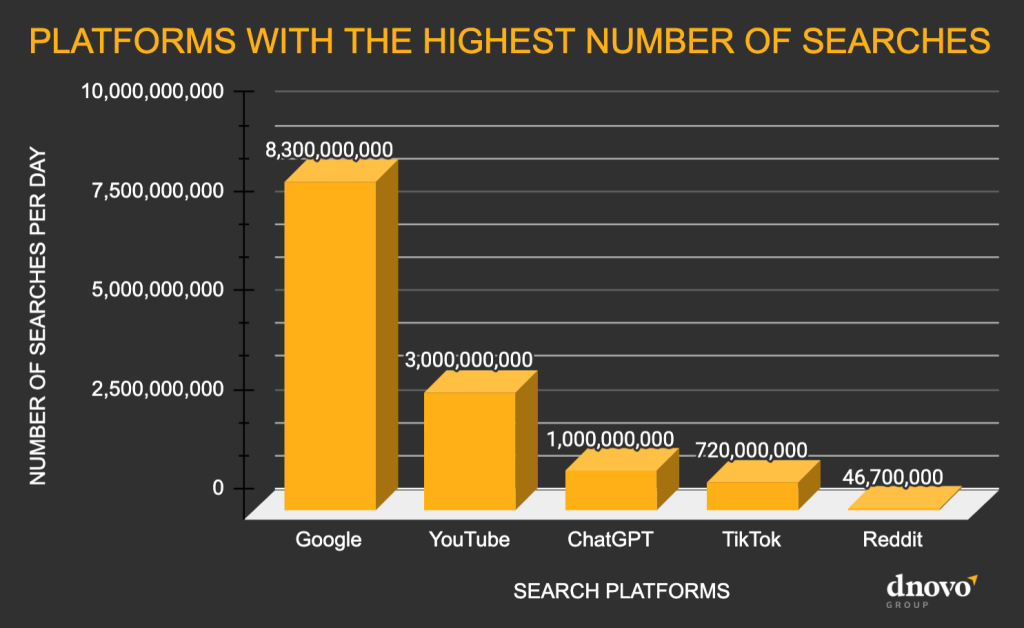
Chart for platforms with the highest daily searches in 2024.
Originally perceived as an app for entertainment and quick-hit viral videos, TikTok surprised us when it started prioritizing educational content. Brands quickly caught up to tap into the vast user base. However, TikTok’s existence is under question, particularly in the U.S. and Canada. Whatever comes after the 90-day grace period— which put TikTok’s potential U.S. ban on hold— may ripple across its northern neighbor. At stake is not just the platform’s ownership but the reach of brands and the audiences they’ve cultivated.
Given the accelerating pace of digital marketing, you’ve got to ask: How will these developments affect your physical therapy business? How can getting on these trends give you a competitive advantage? Will your current marketing efforts still pay off?
We’ll address these questions and others in an upcoming section of this guide, “how to market physical therapy practice.”
Now, let’s talk about two more methods: traditional marketing and experiential marketing.
Traditional marketing
These are offline techniques used to reach customers on traditional, non-digital channels. Common ones are:
- Print advertising: Newspapers, magazines, brochures
- Broadcast advertising: TV, radio
- Outdoor advertising: Billboards, posters, transit ads
- Direct mail: Flyers, postcards
- Telemarketing: Cold calling
- Guerrilla marketing: Street art, flash mobs, and viral campaigns.
What should you replan?
As a digital marketing company, we can only speak to what we know (digital media), but there’s an obvious trend shaping the media landscape in Canada. Print media is giving way to digital, driven by consumer preferences for convenience, speedier content discovery, and superior audiovisual quality.
Digital platforms simply outperform traditional formats in these respects.
Statistique Canada shared data from the 2020 General Social Survey on Social Identity, suggesting that print, television, and radio still generate some impact.
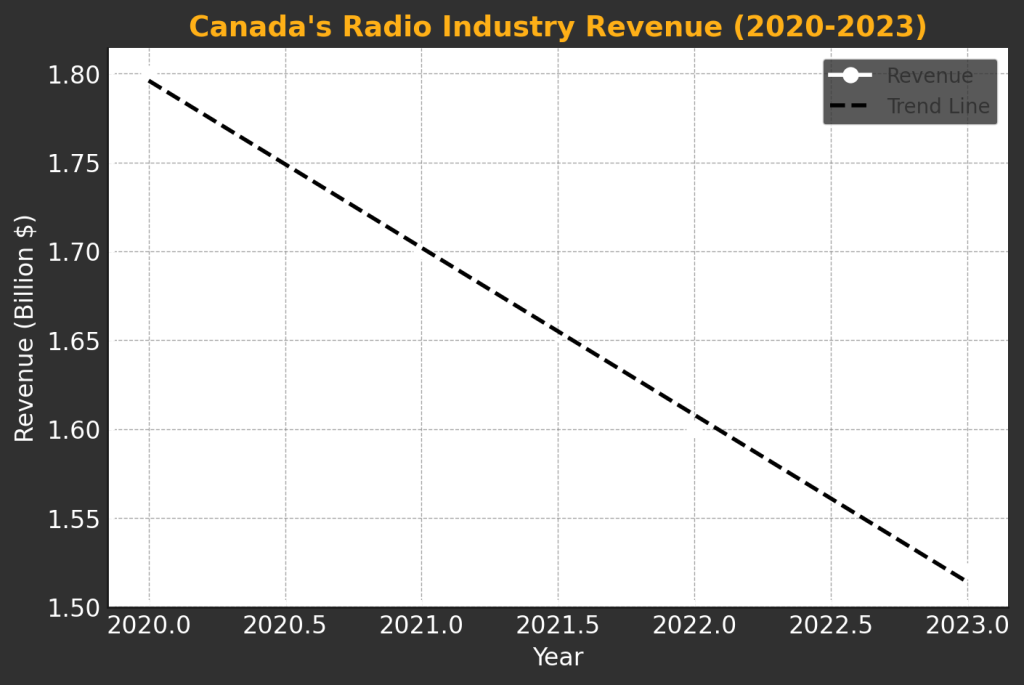
Chart indicating a decline in the Canadian radio industry, reflecting its traditional marketing state.
However, a more recent report from Statista has a nuanced take. Canada’s radio industry reported $1.52 billion in revenue in 2023. This is part of a broader trend of gradual, consistent decline in revenue since 2020. It’s fair to infer that fewer Canadians are paying for radio broadcasts these days.
So, if you decide to invest in traditional physical therapy marketing, the benefits should outweigh the risks—or at the very least, match them. It’s also essential to factor in the characteristics of your audience, such as their age and location.
Experiential and relationship marketing
This category centers around relationship building and creating unique customer experiences. It includes:
- Event marketing: Trade shows, webinars, workshops
- Referral and word-of-mouth marketing: Reviews, referral partners, and programs
- Relationship marketing: Loyalty programs, customer success programs.
- Experiential marketing: Pop-up shops, live demonstrations, interactive installations.
What should you replan?
Events, referrals, and networking aren’t things you can sit on the fence about—they should be core to your physical therapy marketing plan. Digital channels can help patients discover you, but true authority building comes from personal connections. Nearly 88 percent of people trust word-of-mouth; so, as you establish yourself as a trusted expert, organic word-of-mouth marketing takes over—patients start discussing you online and offline.
This is how you create a memorable brand.
The gain here is that experiential and digital marketing don’t have to compete; they work best together. For example, working with referral partners (a strategic business ally) like chiropractors, and using chiropractic marketing strategies alongside physical therapy can help more people access care that supports whole-body healing. You can then ask existing patients to write reviews, especially after a successful outcome, such as pain relief or recovery. Those stories can be repurposed as medical videos, case studies, articles, and quotes.
Pluses and minuses of physical therapy marketing strategies
Of these categories, digital marketing for physical therapy has become the most dominant. It’s cost-effective, measurable, and delivers a higher Return on Investment (ROI). Research shows that traditional marketing yields 50 percent fewer interactions with customers than digital methods.
Traditional marketing is also more expensive and requires more effort to implement. That said, traditional media could be viable in the right context.
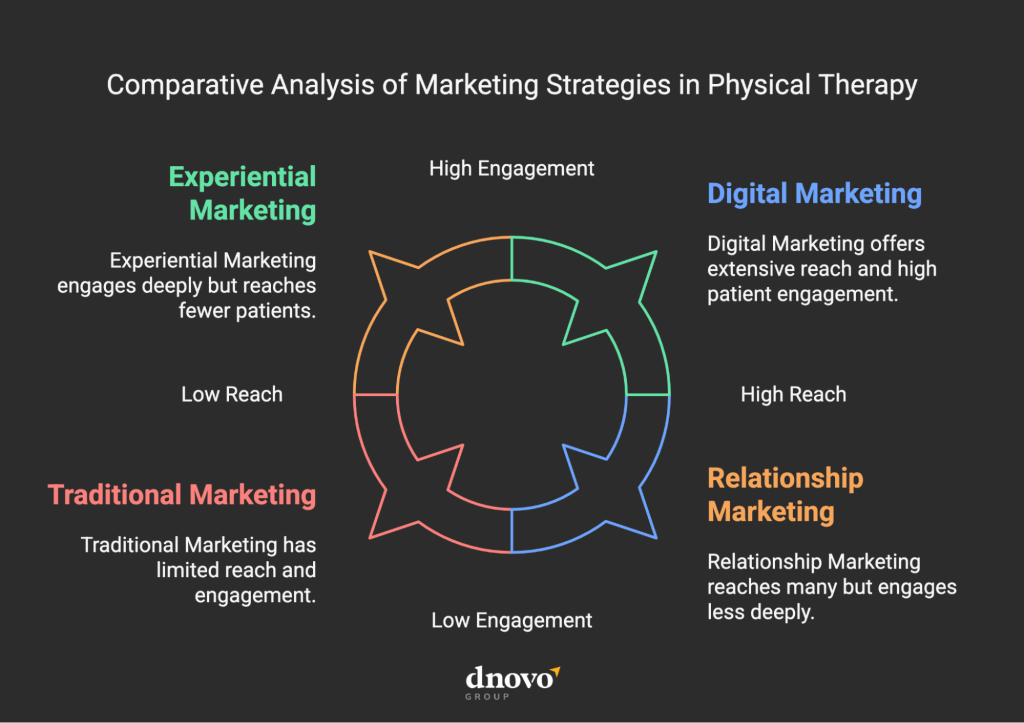
Pros and cons of different marketing strategies.
Experiential and relationship marketing are proficient strategies for physical therapy, but they are about the priciest. For instance, the cost of exhibiting at trade shows can range from $5,000 to over $100,000, which by most standards, is outrageous for a single medium.
In contrast, a digital marketing campaign can be launched across multiple channels like social media, email, and websites at a fraction of the cost.
If you’re a smaller brand, sticking to webinars, feedback surveys, and easy-to-run demos might be the smartest move because they’re affordable and give you room to experiment.
So, when should physiotherapists opt for digital, traditional, or experiential marketing? It depends on your target audience. Let’s chat a bit about it.
The Ideal Profile of Physical Therapy Patients
When marketing physical therapy, it’s not enough to throw out a broad message and hope the right people find it. Just like any community, each individual has exclusive needs, challenges, and goals. It’s important to do the hard work of making sense of who they are, not just as potential patients but as people facing specific struggles in their lives.
Simultaneously, you’ll glean their social mannerisms. For example, Gen Z and Millennials spend more time on social search than conventional Google searches. Meanwhile, Gen X blends both search engines and social media in their search habits. Although Baby Boomers are not digital natives, they have acclimated well to online search.
Since your competitors appeal to the same audience, looking into their data will tell you a lot about yours.
The final profile of your target persona will be very detailed. It should feature:
Demographics. Basic personal details like age, gender, location, occupation, education, marital status, and family size.
Psychographics. Personality traits, interests, hobbies, lifestyle choices, values, and beliefs that influence decision-making.
Socioeconomics. Income level, education background, employment status, financial priorities, and social class.
Challenges. Pain points, struggles, and obstacles preventing them from achieving their goals.
Deepest desires. Core motivations, aspirations, and the emotional or practical outcomes they seek.
Solutions. People, products, services, or strategies that can effectively address their challenges and help them achieve their goals.
Let’s illustrate with Sarah as our example—she’s dealing with chronic pain, and here’s how her profile would look.
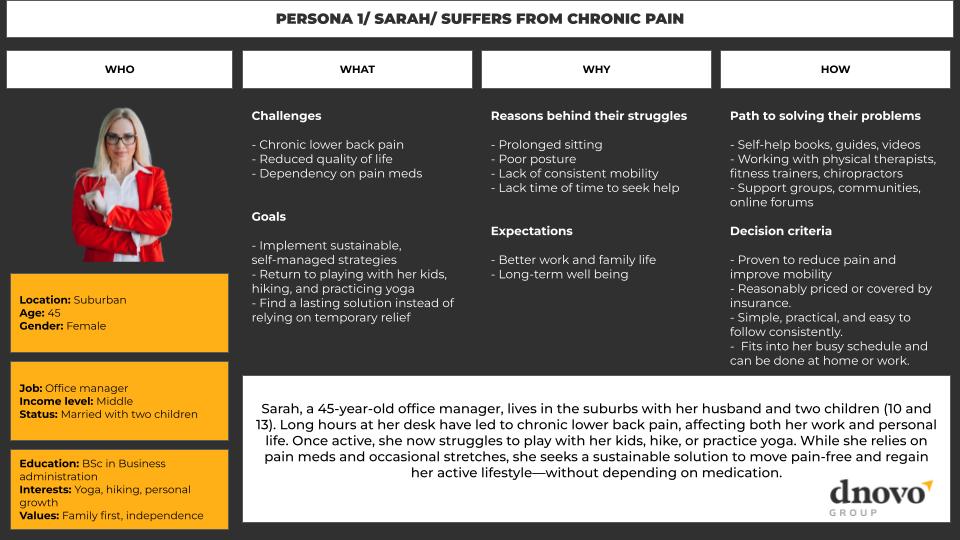
Patient profile for physical therapy.
Think of it this way: if you’re treating Sarah, a 45-year-old who’s been struggling with chronic back pain, you can’t just offer her a one-size-fits-all solution. You need to understand her life deeply, her habits, and her frustrations. The more you align your treatment to her individual needs, the more likely she will trust you with her care.
How to Market a Physical Therapy Clinic: Strategy and Plan
We’ve already established a few key things:
- There’s demand for physiotherapy in Canada, but not enough physiotherapists to meet it.
- In 2025, digital marketing for physiotherapy is going to look very different.
- A strong marketing strategy will blend a variety of tactics but lean heavily on digital efforts.
- To succeed, you need to get specific about who you’re trying to reach—your market, audience, and even the individual persona you’re targeting.
That’s the theory. Let’s talk about strategizing and planning.
Strategy vs. plan
Foremost, here’s something to clear up: strategy and planning aren’t the same thing. Your strategy is the big picture—the overarching list of goals you’re working toward. It’s where you decide the why and the what.
In business terms, this could pass as the OKR (Objectives and Key Results)—fancy words for “what are we trying to achieve, and how do we measure it?”
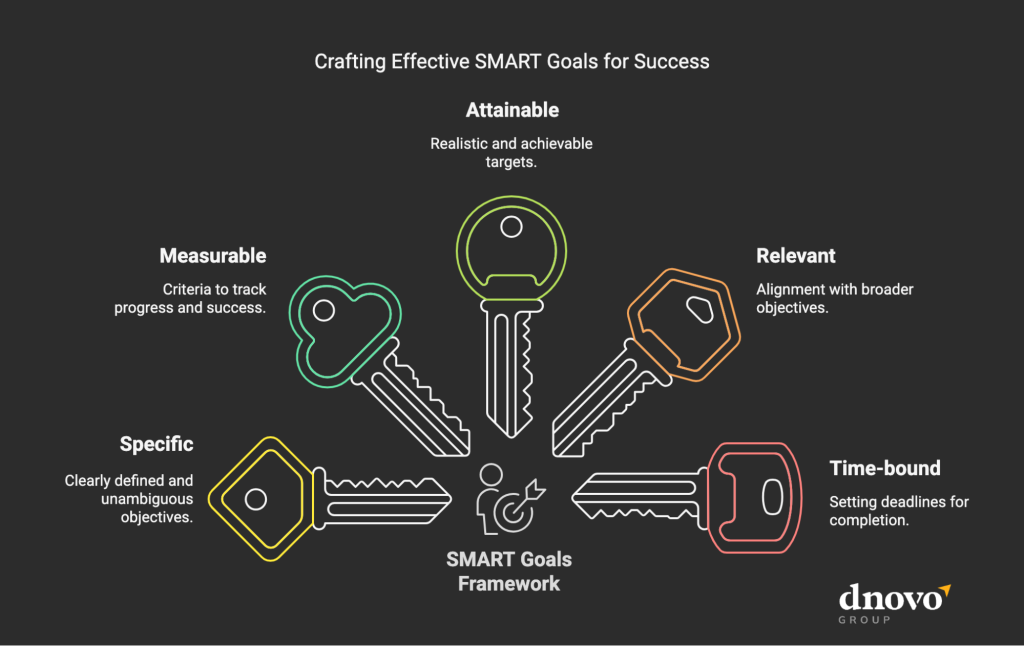
An illustration of the smart framework for marketing planning.
Your plan, on the other hand, is your step-by-step how. It’s measurable, specific, and actionable. Businesses often use the SMART framework to build their plans:
- Specific
- Measurable
- Achievable
- Relevant
- Time-bound
Here’s an example (for SEO).
Strategy:
Increase the number of people finding our site organically by targeting specific, high-volume search terms.
Plan:
- Use tools like SEMrush or Ahrefs to find five high-traffic keywords every month.
- Write and publish two blog posts a week that are optimized for these keys.
Now that we understand the difference, let’s see how to create a digital marketing strategy for physical therapy.
It all starts with your website. A site is an online space where prospective patients will learn about your services, book appointments, or make purchases. Every other marketing effort—social media, email campaigns, or online ads—works to drive people to your website.
Examples of physical therapy websites to inspire yours
Your medical website design shapes a patient’s first impression of your professionalism and the scope of your services. With that in mind, we explored two sites that stood out.
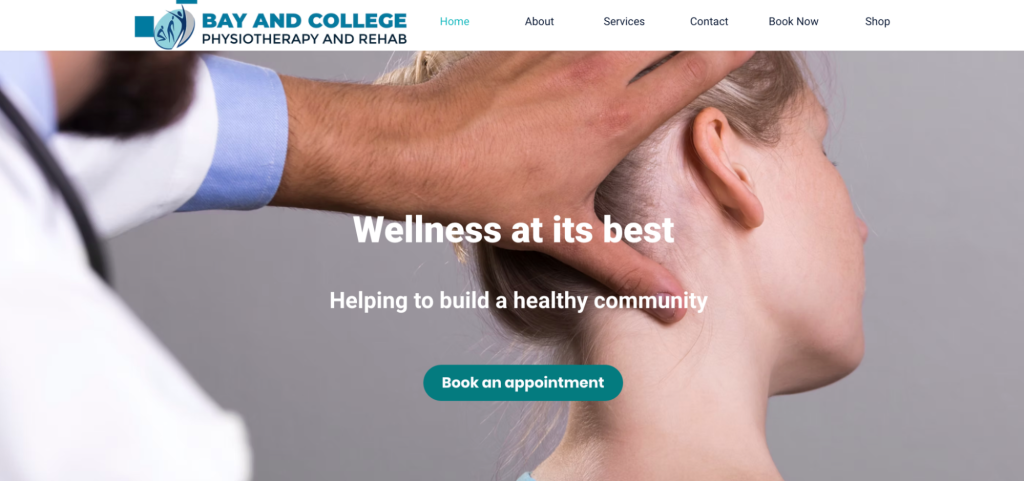
Example of a physical therapy website – rehabsclinic.ca
Bay and College Physiotherapy and Rehab. The interface is sleek and unmistakably action-oriented. From the moment you land on the site, you’re prompted to take the next step. This website also nails it in terms of the user experience. For example, the types of physical therapy services are apparent, and the animations make it feel almost like sliding across a glossy surface. Essential pages—contact, shop, about, and booking—are structured in for navigational ease.
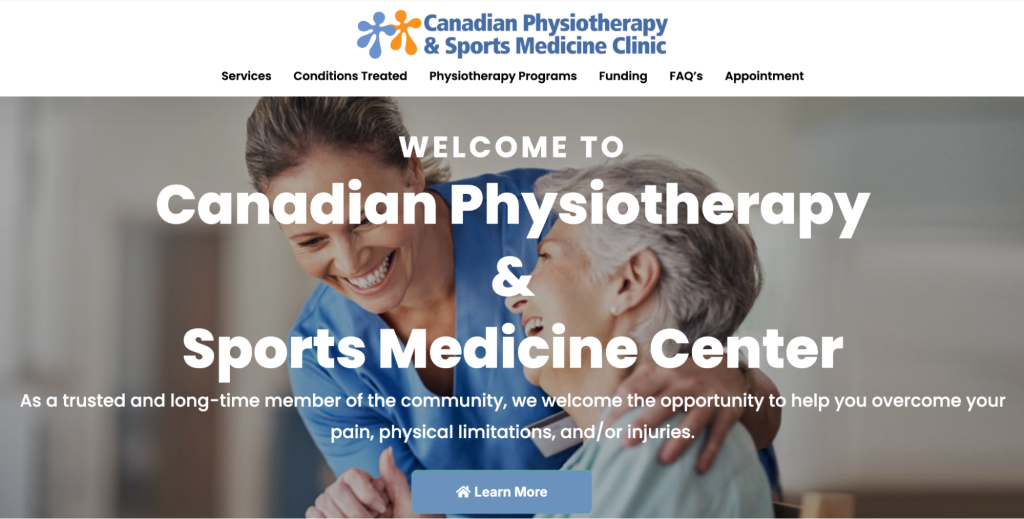
Example of a physical therapy website – canadianphysiotherapy.ca
Canadian Physiotherapy & Sports Medicine Clinic. This site also encourages immediate action while striking a balance between bold and sophisticated. It instantly comes off as a clinic built for Canadians too. A strategically placed benefits section offers prospective patients a persuasive look at what they could gain from treatment, while the features segment underscores what sets the clinic apart. Beyond the basics, pages such as FAQs, conditions treated, and physiotherapy programs are included.
Top 5 Physical Therapy Marketing Strategies for Canadian Physios
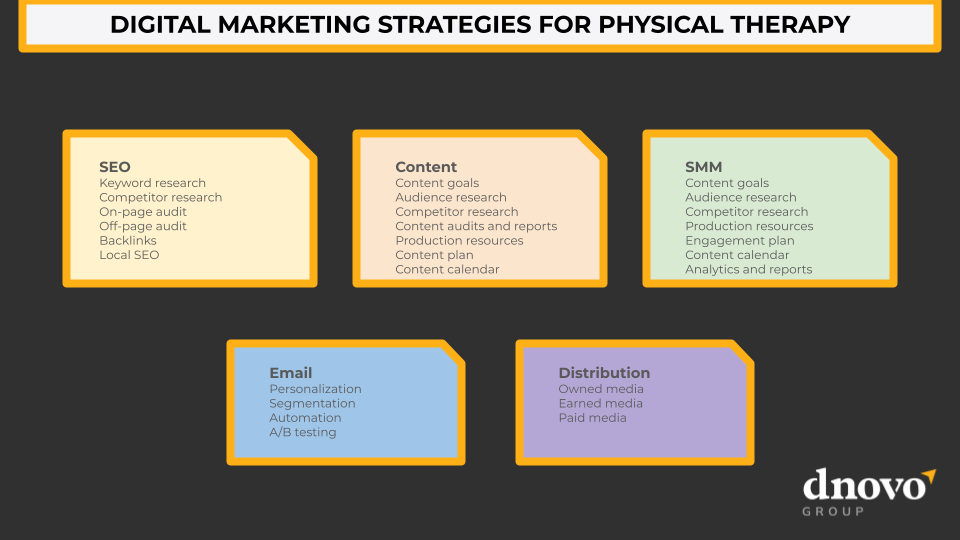
A breakdown of digital marketing strategies for physical therapy.
Let’s get down to your strategies for digital channels.
SEO strategy
A medical SEO strategy culminates all your “how-to-rank” on Google activities. The preliminary step is to assess your SEO performance. You want to keep an eye out for your organic traffic, keyword rankings, and backlinks.
SEO tools such as Ahrefs, Semrush, or Google Analytics make it easier to spot the good and problematic areas. According to Ahrefs, the six biggest SEO challenges in 2024 were about:
- Google’s frequent updates
- Catching up with competitors’ rankings
- Lack of or minimal clicks
- Hard-to-rank sites
- Content revisions
- SEO budgets
Your SEO strategy should address these problem areas. If you’re starting from scratch, it would be more practical to build a strategy from the ground up.
Develop a keyword plan. At the core of SEO are keywords. These are the terms potential patients type into Google when searching for physical therapy services.
All keywords tie back to search intent, which is why people search for physical therapy in the first place.
Search intent falls into four groups:
Informational. Users want answers. For instance, “What does physical therapy involve?”
Navigational. They’re looking for a specific website or sections of a site, such as “ABC Physical Therapy Clinic website.”
Transactional. Patients are ready to take action, like booking an appointment: “Best physical therapy clinic near me.”
Commercial. They are comparing options, e.g., “Top-rated physical therapy clinics in Toronto.”
Central to your plan is keyword research, which will enable you to identify keyword gaps (terms you’re not ranking for yet) and create a list. You do so in three stages:
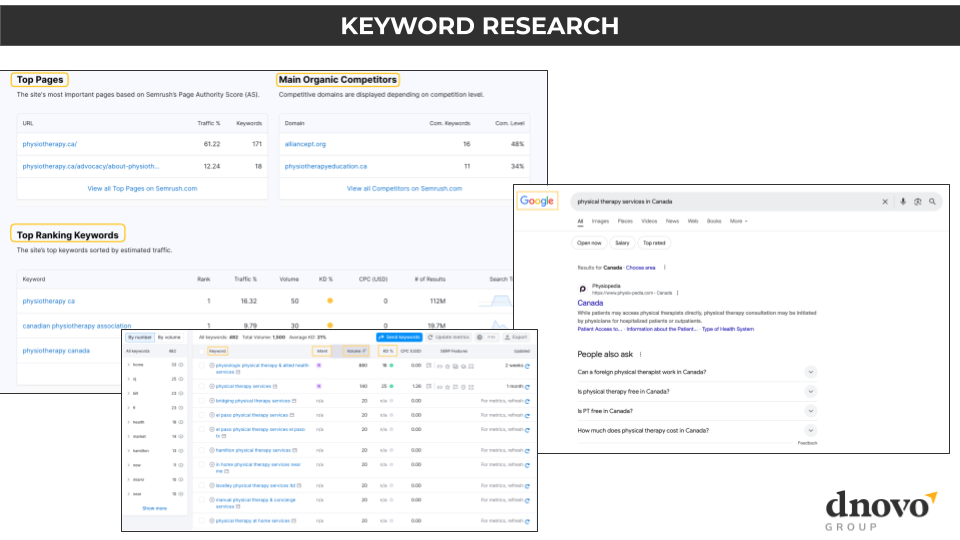
Image showing key SEO research components: competitor analysis, organic search, keyword volume, difficulty, and search intent.
Keyword discovery. This is about finding relevant keywords. For this, you can:
- Use Google autocomplete by typing “physical therapy”. Add letters (A – Z) after the phrase to see what comes up.
- Leverage SEO tools to uncover high-performing keywords and analyze trends in your local market.
- Analyze competitors and catch which keywords they’re ranking for using the same tools.
- Ask your patients what they searched for.
Keyword validation. You want to verify the quality of your keywords. A good keyword should characterize:
- Search volume: Ideally, it should have 100 to 1,000+ monthly searches.
- Brand relevance: The term must align with your services.
- Competition level: Look for low to moderate difficulty scores (under 30).
- Local intent: Prioritize terms connected to your location, like “physical therapy in Calgary.”
Keyword tracking. This phase involves organizing your keywords for easy retrieval.
- Group keywords: Cluster them by themes, such as “sports injuries” or “post-surgical rehab.”
- Collect keywords: Use Google Sheets to store your keywords, search volumes, and competition scores.
Perform on-page SEO audit. On-page SEO audits help assess a site’s technical, content, and usability aspects to ensure it conforms with search engine algorithms and provides a good user experience.
The steps taken after an audit to improve your site are referred to as website optimization. One major aim of optimization is to improve underperforming pages in terms of traffic, conversions, or rankings.
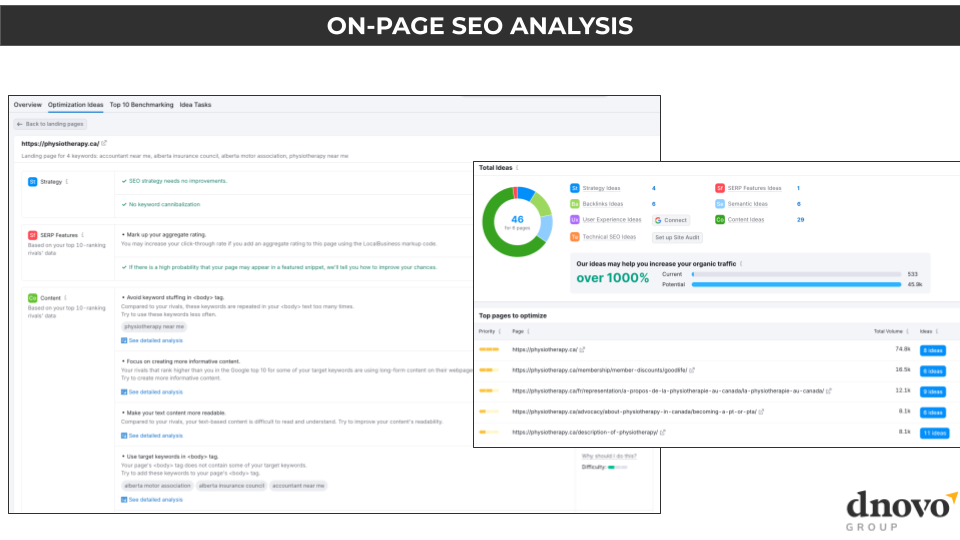
Image showing results of on-page SEO analysis with score and optimization tips.
During on-page SEO audits, you’d also evaluate how well the content and structure of each page fit with search intent and keyword targeting while remaining user-friendly.
Every page follows a default structure or syntax that search engines can easily pick up on. A well-optimized page composes critical elements like:
- Title tags: This is the title Google shows users when they search for terms you rank for. Keep your titles under 60 characters and make sure they include your primary keyword.
- Metadata: This is often a description of a page that summarizes everything in under 150–160 characters. Integrate a keyword or two into your metadata to boost clicks.
- Header tags: These provide hierarchical organization for a page and help visitors navigate more easily. Header tags range from H1 to H6. Use H1 for the main topic, H2 for subtopics, and H3 or H4 for finer details.
- Images: Pictures add a strong visual appeal to your site. The higher their resolution, the better. Be sure to include text descriptions, called alt text, with relevant keywords to improve accessibility.
- Links: Links connect different pages. Internal links bond to your pages, while external links point to other sources. Always double-check your links for broken or inactive ones, and only embed links in relevant anchor text.
Conduct an off-page SEO audit. An off-page SEO audit capitalizes on factors external to your website that affect rankings.
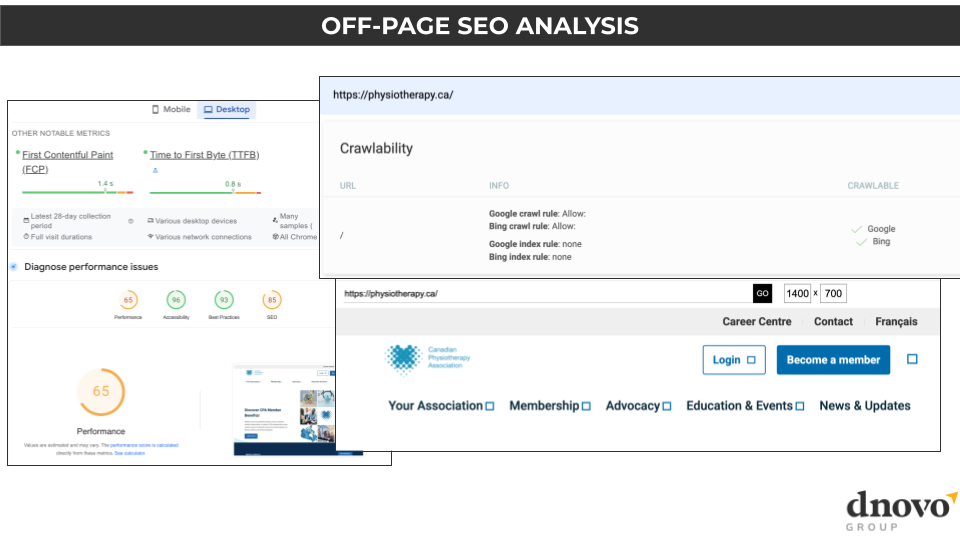
Image explaining different components of off-page SEO analysis: performance, crawlability, responsiveness.
These actions don’t happen on your site but contribute to how search engines perceive it.
Here are some elements to inspect when you do a technical SEO analysis:
- Site speed: This measures how long it takes for your site to load after a user clicks. Aim for a load time of under 3 seconds. Slower load times could cause more users to bounce off your site, increasing the bounce rate.
- Responsiveness: This refers to your site’s ability to adjust to different screen sizes. People access your site from phones, desktops, and tablets, so your site’s design should adapt smoothly across all devices.
- Structured data: This is a special type of code that helps search engines better understand your content. It’s technical and best relegated to SEO experts.
- Crawlability: This is about how easily search engines like Google can read and understand your site. When a search engine crawls through your site, it scans pages to pick up on information. If your site is hard to crawl, some sections might get skipped over, reducing your visibility.
Build backlinks. Backlinks are hyperlinks from other websites to yours. They act as endorsements and tell search engines that your content is important and credible.
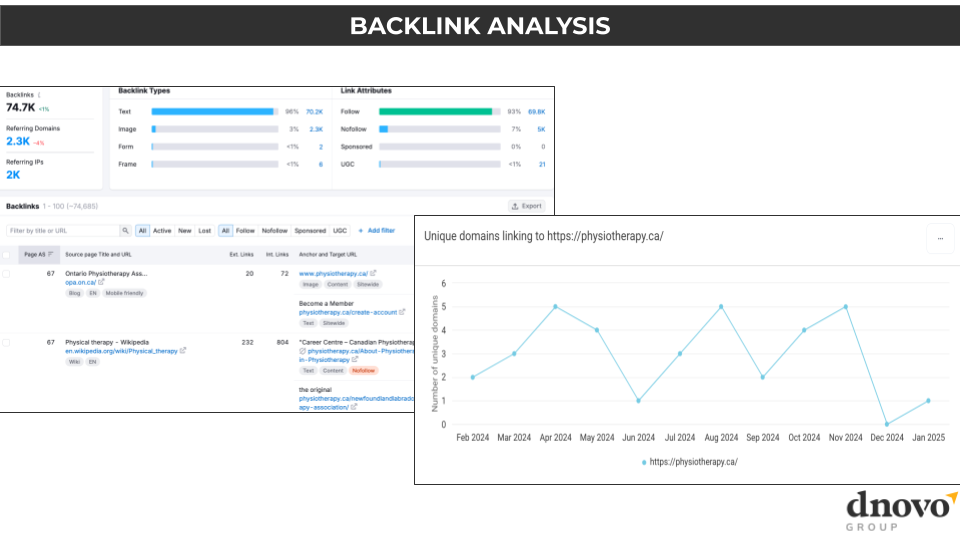
Screengrabs for backlick analysis reports.
The more high-quality backlinks you have, the stronger your site’s authority becomes.
You can build backlinks through:
- Guest posting: You can write your articles for trustworthy websites, as they’ll boost your traffic and authority. Such sites usually have strong domain authority (DA) and are known for being trusted by search engines.
- Local directories: If you list your site on platforms like Yelp or Yellow Pages, you also make it easier to find, especially for local searches.
- Forums: Reddit, Quora, and niche forums (e.g., Physiopedia, Canadian Physiotherapy Association) are great sources for backlinks because they generally have larger audiences than guest posting sites. But links from forums are nofollow because they don’t directly contribute to rankings.
Cover local SEO. If you’re targeting mainly local clients, localized search engine optimization is not negotiable. Optimizing for location-based searches makes sure that people in your area can find you when they look up physical therapy services.
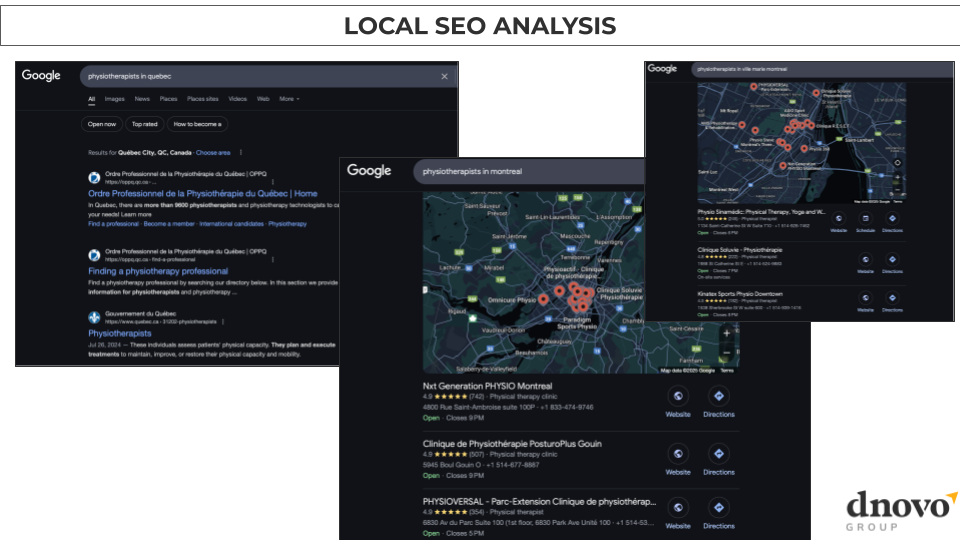
Screengrabs showing local searches for physical therapist services in Canada.
Below are ways you can improve your local searchability:
Google My Business (GMB). Claim and adjust your GMB profile to boost visibility in your province or city.
Local keywords. Work in city-specific or neighborhood-specific keywords, like “physical therapy in [City Name],” to target your local audience more effectively.
Local reviews. Prompt satisfied clients to drop positive reviews on platforms like Google and Yelp, which can help your local ranking.
Content marketing strategy
A content marketing strategy for your physiotherapy clinic should attest to your challenges, goals, and content creation steps. According to Statista’s February 2024 report, content teams are grappling with a few common issues, including:
- Content quality
- Content trends
- Content personalization
- Content budgets
To confront such issues and those particular to your circumstances:
Define your goals. We’ve already discussed the differences between strategy and goal, and how the SMART framework can guide you in them.
After setting your priorities, write them down. Also, remember that tracking your results is just as necessary.
Understand your audience. Any marketing strategy needs a detailed profile of your prospective patients. Refer to the ideal patient profile section we covered earlier for an example.
Describe your resources. You’ll want a clear picture of what you need to kick off your content creation process:
- People: This includes the number, skill set, and availability of the people who will make up your physical therapy marketing team.
- Tools: Every team needs specific tools. Sometimes, a single toolkit can serve multiple teams across different marketing functions.
- Budget: Your budget encompasses the total cost of marketing, as well as any miscellaneous expenses that come up.
Filling out this information gives a feel of which projects are feasible and how to allocate resources appropriately.
Conduct a content audit. A content audit is similar to an SEO audit but aids a different use. It begins with appraising your current content library, which houses all your marketing materials. You decide what to keep, improve, or remove based on their performance.
- Keep: If the content is performing well and bringing value to your customers, leave it the same.
- Improve: If the content is underperforming or can be enhanced, update it.
- Remove: If the content has little value or minimal potential, delete it as it could detract from your overall efforts.
Perform and competitor analysis. A market review involves staying attuned to industry trends and discussions. Utilize trend-analysis tools like Google Trends, BuzzSumo, Exploding Topics, and Twitter (X) to track what’s resonating in your space.
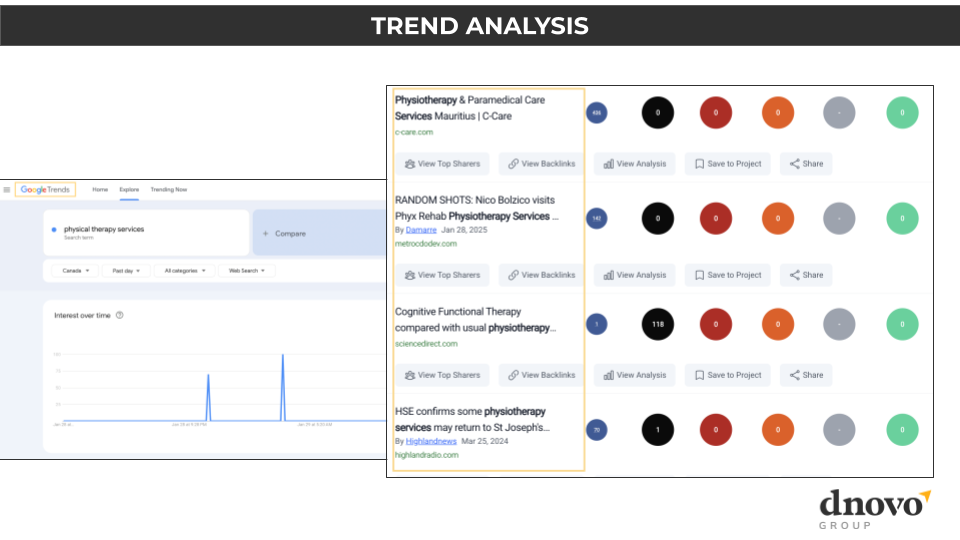
Image showing trend analysis.
On the other hand, you can evaluate competitors with SEO tools to see what is working for them, and importantly, how to use it for your own advantage.
Identify content gaps. A content gap, much like a keyword gap, highlights flecks in your content library that lack certain marketing materials. These gaps may be in the form of missing topics, underexplored information, or perspectives.
To pick them out, you can ask your patients what they like, examine competitors’ content, and stay up-to-date with industry trends. You can articulate this as new content ideas and classify them based on where your target audience is in their journey. You’d better appreciate this using a funnel.
A content marketing funnel is like a map that tracks the journeys of potential patients through various stages, showing how you can ramp up your sales and marketing efforts to capture their interest at key touchpoints.
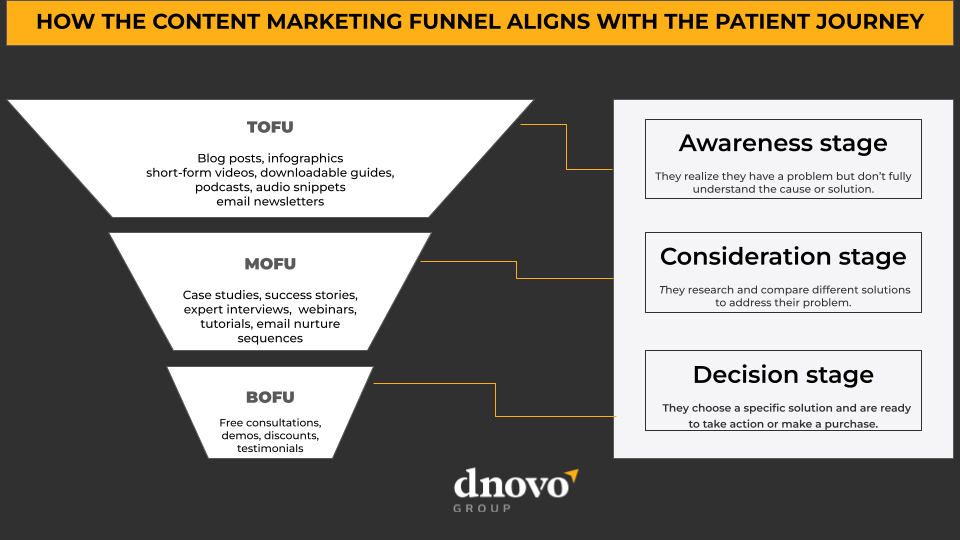
Matching the patient journey and content marketing funnel.
Your content is one of those touchpoints, while the stages below are where you engage with clients:
- Awareness: Patients aren’t aware of the reasons or extent of their problems, but you can educate them and offer solutions. Content for this stage will be at the top of your funnel.
- Consideration: Patients now comprehend their problems and are aware of your brand, but they’re weighing their options. Content for this audience goes to the middle of the funnel.
- Decision: Patients are prepared to make a decision, and they may need evidence or case studies to finalize their choice. Bottom-of-the-funnel content serves this need.
Set content guidelines. Your content guidelines shape how your brand manifests in written and visual contexts. They should outline:
- Tone of voice: This document defines your brand’s personality across all content. Is it professional? Playful? Or a mix of both?
- Style guide: This clarifies your design standards to ensure your graphics match your brand identity.
- Rules: This document breaks down essential details, such as how to properly use your brand name, the structure of your content, punctuation, and other conventions—such as Canadian writing standards, and connotations, if applicable.
Roll out a content plan and calendar. Your content plan asserts what you’ll publish, while the calendar helps schedule it. You can combine both or keep them separate.

Example of content plan for physical therapy.
Your plan lists:
- Formats: Determine the type of content you will create— blog posts, videos, ebooks, or something else. A 2025 survey from the Content Marketing Institute and Hootsuite’s report on effective content types for social media emphasize that videos are the best-performing ones.
- Topics: Choose topics with your audience that are relevant to your brand, and align with the chosen content format.
- Frequency: Decide how often you plan to produce and publish content, keeping in mind that quality is far more important than quantity.
- Distribution: Consider how you’ll amplify your content. Utilize channels like social media, email newsletters, and other avenues to ensure it reaches a wider audience.
- Notes: Include any additional information that’s relevant to your practice and your target audience. For instance, the goals of each content for your customers and your business.
Social media marketing strategy
A social media marketing strategy is an extension of a content marketing strategy but with subtle modifications. The metrics you measure will differ from those you track with content marketing. And even within social platforms, those metrics will vary.
Your content formats and ad campaigns too need adjusting. What works on LinkedIn may not work on Facebook, and vice versa. Perhaps, a colossal shift in your strategy will be the engagement plan. This plan spells out how you connect with followers through comments, direct messages, live sessions, and other interactions.
And a decisive part of that engagement involves social listening—keeping your ears to the real thoughts and feelings of people on social media so you can respond more naturally.
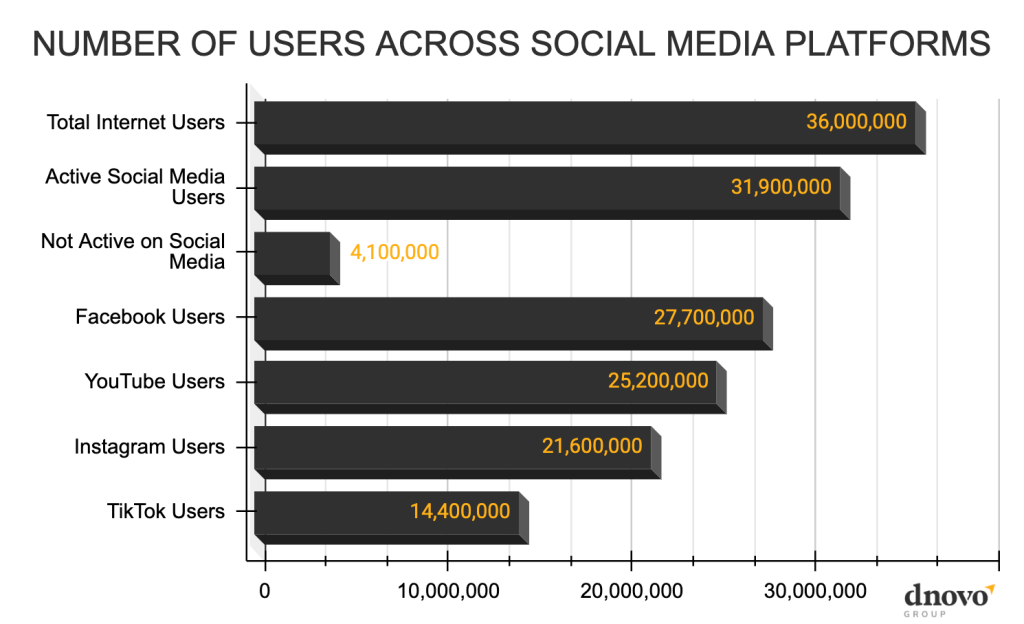
Chart portraying social users by platform and total inactive users.
Another thing to consider is how social media platforms are stacking up. Here’s what social media statistics from Statista say for Canadians:
- Over 36 million people use the internet in Canada, and around 31.9 million are active on social media.
- Social media in Canada is more about private, personal conversations than just collecting likes or followers.
- Facebook is by far the most dominant social platform in Canada, with 77 percent of online users engaging with it. The majority of users are between 25 and 35 years old, proving that Facebook isn’t just for the older crowd or boomers.
- YouTube and Instagram also have strong penetration rates, and Facebook’s user base in Canada is expected to reach 35 million by 2027.
- TikTok may have global appeal, but its Canadian audience of 14 million is much smaller compared to Facebook’s. Still, 37 percent of TikTok users in Canada are Gen Z, the generation that will influence the future of social media.
Besides the stats above, we sifted through HubSpot’s 2024 report, and found these to be the prevailing issues in SMM:
- Creating engaging content
- Keeping up with algorithm updates and platform features
- Coming up with fresh content ideas
- Expanding audience reach
- Lead generation
- Staying on top of new trends
Your strategy should be able to fix these headaches and transform as needed. A notorious misconception, though, is that SMM drives traffic and conversions in the same way that web channels do. In reality, SMM doesn’t always lead to direct conversions. It powers up your brand awareness, visibility, authority, and crucially, personal, human-level connections with your followers.
In the past, brands on social media came off as cold and robotic, and this created a barrier between them and their audience. People would engage minimally—by liking a post and quickly scrolling past it. But that is no longer the state of affairs.
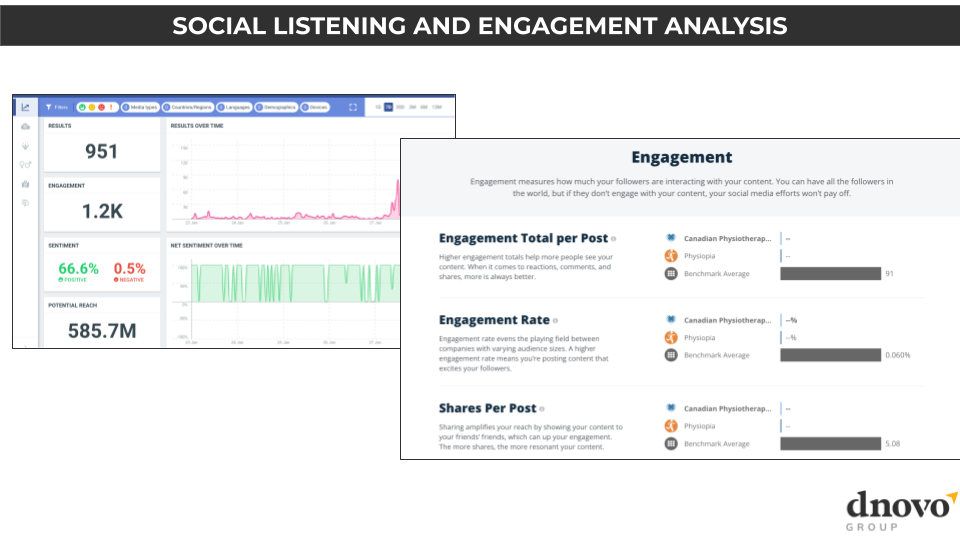
Image revealing social media engagement and audience sentiment analysis for physical therapy.
According to Hootsuite’s social media report for 2025: Brands are getting better at not just listening but sounding relatable and joining the conversation. This trend, called trend jacking, lets them jump on the micro-viral content in real-time. For example, more brands have been seen participating in creators’ comments sections and engaging with users.
Email marketing strategy
Email marketing isn’t dead—far from it. According to Made in Canada, 83 percent of Canadian companies still use email as a critical part of their marketing efforts. With an average email open rate of 20 percent and over 26 million Canadians actively using email, there’s still plenty of potential here.
If you’re marketing a physical therapy practice, email deserves a spot in your toolkit. However, it’s important to note that email is not as effective as web and social channels. For that reason, we’ll keep our focus on it less explicit.
Here’s what it constitutes:
Audience segmentation. Dividing your email list based on behavior, demographics, or purchase history.
Campaign objectives. Defining goals, such as product promotion, nurturing leads, or customer retention.
Email content. Crafting personalized messages, such as newsletters, offers, or product updates.
Automation. Setting up workflows for onboarding, cart abandonment, and follow-up emails.
A/B testing. Testing subject lines, CTAs, or content layouts to optimize performance.
Deliverability optimization. Ensuring emails land in inboxes, not spam folders.
Analytics. Tracking key metrics such as open rates, click-through rates, and conversion rates to measure success.
Everything considered, the rule of thumb is to respect your audience’s privacy. Always give recipients the option to opt in or out.
Distribution strategy
To get the most out of your content, you need a plan for how to distribute it. It can be across inbound or outbound channels. Your distribution outlets include:
Owned media. These are channels you control – your website, email list, and social pages.
Earned media. These are ones you don’t own or control. They’re either paid or free to use. Some strategies here would be getting featured on industry blogs, securing PR mentions, and leveraging influencer shoutouts to expand your reach.
Paid media. These are strictly paid channels. You can invest in PPC ads, sponsored posts, or paid promotions to target specific audiences.
Takeaway
If you’re really asking what breakthrough physical therapy marketing looks like today, we’d narrow it down to five core shifts:
- Don’t need to reinvent your digital marketing wheel—your Standard Operating Procedures (SOPs) still matter. But what you can—and should—do is adapt those practices to align with the reality of what’s working right now.
- Integrate AI where it makes sense and upscale as the trends evolve—because they always do. Search marketing is another key pillar. Social search, voice search, and the emerging field of generative engine optimization have plenty of opportunities you can explore.
- On the social and content front, the spotlight is on thought leadership. It’s time to think beyond your company. Build a personal brand, and let your employees become the voice of your business.
Dnovo Group positions itself at the front of these evolutions. We’d continue to support physical therapists in Canada with the best professional advice and expertise to help them deliver better care.
FAQs about Physical Therapy Marketing
How do you market a PT in Canada?
To successfully market physical therapy services in Canada, PTs should employ a multi-channel strategy that includes both digital marketing and community-focused initiatives.
How big is the physical therapy market in Canada?
The physical therapy market in Canada is valued at over $2.5 billion annually. It’s evident the demand for physical therapy services is on the rise.



